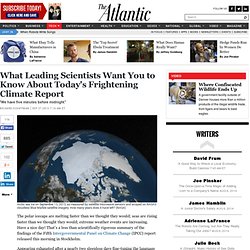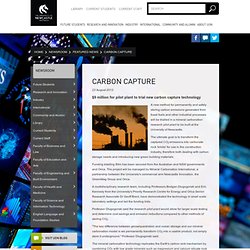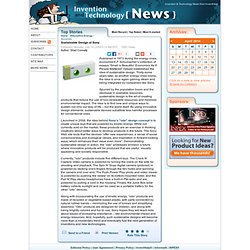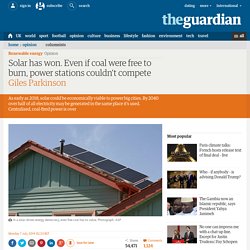

The Story of Sustainability in 2018: “We Have About 12 Years Left” What Leading Scientists Want You to Know About Today's Frightening Climate Report. The polar icecaps are melting faster than we thought they would; seas are rising faster than we thought they would; extreme weather events are increasing.

Have a nice day! That’s a less than scientifically rigorous summary of the findings of the Fifth Intergovernmental Panel on Climate Change (IPCC) report released this morning in Stockholm. Appearing exhausted after a nearly two sleepless days fine-tuning the language of the report, co-chair Thomas Stocker called climate change “the greatest challenge of our time," adding that “each of the last three decades has been successively warmer than the past,” and that this trend is likely to continue into the foreseeable future. Pledging further action to cut carbon dioxide (CO2) emissions, U.S. Secretary of State John Kerry said, "This isn’t a run of the mill report to be dumped in a filing cabinet.
And that science needs to be communicated to the public, loudly and clearly. But there is a lot that we still don’t understand. Carbon Capture / Featured news / Newsroom. 23 August 2013 $9 million for pilot plant to trial new carbon capture technology A new method for permanently and safely storing carbon emissions generated from fossil fuels and other industrial processes will be trialled in a mineral carbonation research pilot plant to be built at the University of Newcastle.

The ultimate goal is to transform the captured CO2 emissions into carbonate rock 'bricks' for use in the construction industry, therefore both dealing with carbon storage needs and introducing new green building materials. Funding totalling $9m has been secured from the Australian and NSW governments and Orica. The project will be managed by Mineral Carbonation International, a partnership between the University's commercial arm Newcastle Innovation, the GreenMag Group and Orica. Professor Dlugogorski said the research pilot plant would allow for larger scale testing and determine cost savings and emission reductions compared to other methods of storing CO2. Sustainable Sites Initiative.url. Sustainable Design at Sony.url. Published in 1973 during the energy crisis, economist E.F.

Schumacher’s collection of essays “Small is Beautiful: Economics As If People Mattered” helped established the idea of sustainable design. Thirty-some years later, as another energy crisis looms, the idea is once again gaining steam and being integrated by companies like Sony. Spurred by the population boom and the decrease in available resources, sustainable design is the art of creating products that reduce the use of non-renewable resources and minimize environmental impact. The idea is to find new and unique ways to sustain not only our way of life – but the world itself.
By using innovative design elements, sustainable devices substitute less harmful processes for conventional ones. Launched in 2006, the idea behind Sony’s "odo" design concept is to create unique toys that are powered by kinetic energy. Currently, “odo” products include five different toys. American Wind Energy Association . . . Clean Energy for ou.url. POWER Magazine Power generation news and jobs in coal, gas, nuclear, renewables.url.
International Energy Agency.url.
Solar has won. Even if coal were free to burn, power stations couldn't compete. Last week, for the first time in memory, the wholesale price of electricity in Queensland fell into negative territory – in the middle of the day.

For several days the price, normally around $40-$50 a megawatt hour, hovered in and around zero. Prices were deflated throughout the week, largely because of the influence of one of the newest, biggest power stations in the state – rooftop solar. “Negative pricing” moves, as they are known, are not uncommon. But they are only supposed to happen at night, when most of the population is mostly asleep, demand is down, and operators of coal fired generators are reluctant to switch off.
So they pay others to pick up their output. That's not supposed to happen at lunchtime. The influx of rooftop solar has turned this model on its head. The impact has been so profound, and wholesale prices pushed down so low, that few coal generators in Australia made a profit last year. The answer is no. Coal, of course, will never be free.
Biofuel. Biogas. Algae oils. Energy Management. TH Home.